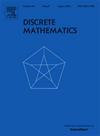一个无符号拉普拉斯谱Erdős-Stone-Simonovits定理
IF 0.7
3区 数学
Q2 MATHEMATICS
引用次数: 0
摘要
著名的Erdős-Stone-Simonovits定理表明ex(n,F)=(1−1χ(F)−1+o(1))n22,其中χ(F)是F的色数。2009年,Nikiforov用邻接谱半径证明了Erdős-Stone-Simonovits定理的谱扩展。在本文中,我们将建立一个关于无符号拉普拉斯谱半径的统一推广。设q(G)为G的无符号拉普拉斯谱半径,记为exq(n,F)=max (q(G):|G|=nandF G}。众所周知,对于偶数循环,无符号拉普拉斯谱半径的Erdős-Stone-Simonovits型结果不成立。证明了如果F是一个χ(F)≥3的图,则exq(n,F)=(1−1χ(F)−1+o(1))2n。这解决了Li, Liu和Feng(2022)提出的一个问题,对exq(n,F)的估计问题给出了一个完全令人满意的答案。进一步推广了Erdős、Stone和Simonovits的上述结果以及Nikiforov的光谱结果。我们的结果表明,关于无符号拉普拉斯谱半径的Erdős-Stone-Simonovits型结果一般是有效的。本文章由计算机程序翻译,如有差异,请以英文原文为准。
A signless Laplacian spectral Erdős-Stone-Simonovits theorem
The celebrated Erdős–Stone–Simonovits theorem states that , where is the chromatic number of F. In 2009, Nikiforov proved a spectral extension of the Erdős–Stone–Simonovits theorem in terms of the adjacency spectral radius. In this paper, we shall establish a unified extension in terms of the signless Laplacian spectral radius. Let be the signless Laplacian spectral radius of G and we denote . It is known that the Erdős–Stone–Simonovits type result for the signless Laplacian spectral radius does not hold for even cycles. We prove that if F is a graph with , then . This solves a problem proposed by Li, Liu and Feng (2022), which gives an entirely satisfactory answer to the problem of estimating . Furthermore, it extends the aforementioned result of Erdős, Stone and Simonovits as well as the spectral result of Nikiforov. Our result indicates that the Erdős–Stone–Simonovits type result regarding the signless Laplacian spectral radius is valid in general.
求助全文
通过发布文献求助,成功后即可免费获取论文全文。
去求助
来源期刊

Discrete Mathematics
数学-数学
CiteScore
1.50
自引率
12.50%
发文量
424
审稿时长
6 months
期刊介绍:
Discrete Mathematics provides a common forum for significant research in many areas of discrete mathematics and combinatorics. Among the fields covered by Discrete Mathematics are graph and hypergraph theory, enumeration, coding theory, block designs, the combinatorics of partially ordered sets, extremal set theory, matroid theory, algebraic combinatorics, discrete geometry, matrices, and discrete probability theory.
Items in the journal include research articles (Contributions or Notes, depending on length) and survey/expository articles (Perspectives). Efforts are made to process the submission of Notes (short articles) quickly. The Perspectives section features expository articles accessible to a broad audience that cast new light or present unifying points of view on well-known or insufficiently-known topics.
 求助内容:
求助内容: 应助结果提醒方式:
应助结果提醒方式:


